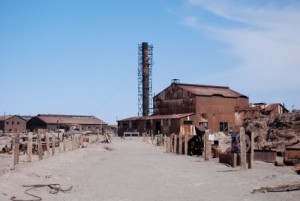
Humberstone Factory. Photo © Wayne Bernhardson.
Most Northern Hemisphere residents think of the Southern Cone countries – Argentina, Chile, and Uruguay – as summer destinations. In the southern winter, of June, July and August, they tend to stay closer to home for their travels, but that means they often miss out on more distant attractions. Thus, over the next several weeks, I’m going to focus on Southern Hemisphere getaways for Northern Hemisphere residents at this time of year.One of those is Chile’s Atacama Desert and, like the Mojave Desert of California and Nevada, it’s often best to visit in winter even though, because of the Pacific Ocean’s cool Humboldt Current, it stays far cooler in summer than the Mojave does. Still, the mild winter are ideal for exploring the backcountry even though the nights get chilly except along the subtropical coast, where temperatures remain comfortable all year, at all hours.
Like the Mojave, the Atacama has its share of ghost towns and, to my mind, they’re one of its real highlights. Unlike the scattered settlements of the Mojave, though, the ghost towns of the Atacama were sprawling company towns that grew up in response to massive surface mining for nitrates. These oficinas operated from the mid-19th century to the mid-20th but, as the nitrate industry declined when petroleum-based fertilizers replaced nitrates for agriculture after World War I, they began to fall into disrepair. Many of them were dismantled for scrap or, infamously, robbed for their wood and other valuable building materials.
Three large oficinas, though, remain reasonably well intact and easily accessible. On the high steppe about 45 km east of the city of Iquique, Humberstone and nearby Santa Laura are a combined UNESCO World Heritage Site that displays a remarkable number of amenities for nitrate miners, including the impressive Teatro Humberstone, built of Douglas fir imported from the United States, and an enormous cast-iron swimming pool that’s now rusting and waterless.
When I first visited here, in 1979, you could actually walk around the ruins and even climb the rafters of structures like Santa Laura’s Planta de Chancado (ore-crusher) but, today, authorities have put more of a premium on safety. Still, you can see walk inside many buildings, climb aboard rusting locomotives from the narrow-gauge rail line, and walk the wraparound porch the borders the Casa del Administrador (administrator’s house) and its tennis courts. It’s easy to spend a morning, afternoon, or even a full day at one of the most picturesque ghost towns this side of Bodie (California). With frequent buses from Iquique, access is easy.
The other major ghost town, slightly less accessible than Humberstone, is Oficina Chacabuco, about 100 km northeast of the port city of Antofagasta. Opened in 1924 to accommodate the new Shanks system of extracting nitrate from ore, it closed its brief life in 1940. Occupying an area of 36 hectares organized in a regular grid, it included a theater larger and more elegant than Humberstone’s and, today, well-preserved frescos still overlook its stage.
Chacabuco, though, also has a darker history – after the military coup of 1973, it was used to house more than 2,200 political prisoners and, though none were executed here, it was surrounded by land mines to discourage escapees. The upper levels of the theater include a photographic display of Chacabuco’s heyday, and information about the prison camp.
Buses from Antofagasta to the city of Calama run along the highway but it’s about four km south of a major highway junction; northbound buses to the city of Arica, though less frequent, will drop you directly at the entrance road. The hop-on, hop-off tour company Pachamama by Bus includes Chacabuco on its Atacama itineraries, which continue to San Pedro de Atacama.